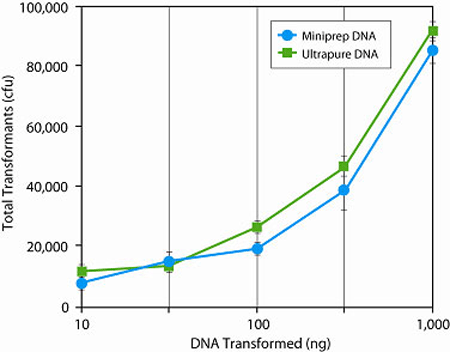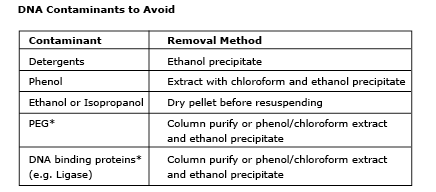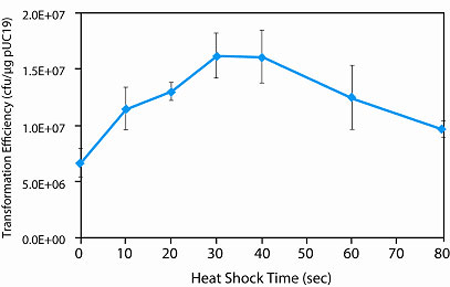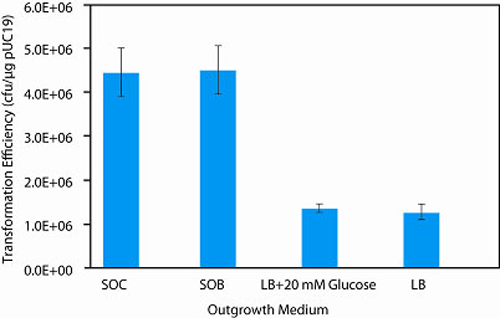NEB® 5-alpha Competent E. coli (Subcloning Efficiency)
Product information| Code | Name | Size | Quantity | Price | |
|---|---|---|---|---|---|
C2988J |
NEB 5-alpha Competent E. coli (Subcloning Efficiency) |
6 x 0.4 ml | - | Unavailable in your region |
NEB® 5-alpha Competent E. coli (Subcloning Efficiency)
Having trouble opening your tubes? NEB Tube Opener can help!
Product Introduction
NEB 5-alpha Competent E. coli is a derivative of the popular DH5α. It is T1 phage resistant and endA deficient for high-quality plasmid preparations.
- Ideal for subcloning efficiency transformations, such as plasmid transformation or routine subcloning
- No dry ice surcharge on competent cell shipments
- Free of animal products
- High efficiency chemical and electrocompetent formats are also available
| Catalog # | Size | Concentration |
|---|---|---|
| C2988J | 6 x 0.4 ml |
- Product Information
- Protocols, Manuals & Usage
- Tools & Resources
- FAQs & Troubleshooting
- Citations & Technical Literature
- Quality, Safety & Legal
- Other Products You May Be Interested In
Product Information
Description
Highlights
- Activity of nonspecific endonuclease I (endA1) eliminated for highest quality plasmid preparations
- Efficient transformation of unmethylated DNA derived from PCR, cDNA and many other sources (hsdR)
- Reduced recombination of cloned DNA (recA1)
- Resistance to phage T1 (fhuA2)
- Suitable for blue/white screening by α-complementation of the β-galactosidase gene
- K12 Strain
- DH5α™ derivative
- Free of animal products
Transformation Efficiency
> 1 x 106 cfu/µg pUC19 DNA Chemically competent E. coli cells suitable for subcloning efficiency transformations, such as plasmid transformation or routine subcloning (e.g,. inserting a 1 kb fragment into a 2 kb vector). The efficiency of these cells is not sufficiently high for most other cloning applications. For that, we recommend NEB® 5-alpha Competent E. coli (High Efficiency) (NEB #C2987) which has 1,000-fold higher transformation efficiency.Genotype
fhuA2::IS2 Δ(mmuP-mhpD)169 ΔphoA8 glnX44 ϕ80d[ΔlacZ58(M15)] rfbD1 gyrA96 luxS11 recA1 endA1 rphWT thiE1 hsdR17- This product is related to the following categories:
- Cloning Competent Cell Strains
- This product can be used in the following applications:
- Transformation
Reagents Supplied
Reagents Supplied
The following reagents are supplied with this product:
| NEB # | Component Name | Component # | Stored at (°C) | Amount | Concentration | |
|---|---|---|---|---|---|---|
Properties & Usage
Antibiotic for Plasmid Selection
| Antibiotics for Plasmid Selection | Working Concentration |
|---|---|
| Ampicillin | 100 µg/ml |
| Carbenicillin | 100 µg/ml |
| Chloramphenicol | 33 µg/ml |
| Kanamycin | 30 µg/ml |
| Streptomycin | 25 µg/ml |
| Tetracycline | 15 µg/ml |
Shipping Notes
- Ships on dry ice
Features
Transformation Protocol VariablesThawing: Cells are best thawed on ice and DNA added as soon as the last bit of ice in the tube disappears. Cells can also be thawed by hand, but warming above 0°C will decrease the transformation efficiency.
Incubation of DNA with Cells on Ice: For maximum transformation efficiency, cells and DNA should be incubated together on ice for 30 minutes. Expect a 2-fold loss in transformation efficiency for every 10 minutes this step is shortened.
Heat Shock: Both the temperature and the timing of the heat shock step are important and specific to the transformation volume and vessel. Using the transformation tube provided, 30 seconds at 42°C is optimal.
Outgrowth: Outgrowth at 37°C for 1 hour is best for cell recovery and for expression of antibiotic resistance. Expect a 2-fold loss in transformation efficiency for every 15 minutes this step is shortened. SOC gives 2-fold higher transformation efficiency than LB medium; and incubation with shaking or rotating the tube gives 2-fold higher transformation efficiency than incubation without shaking.
Plating: Selection plates can be used warm or cold, wet or dry without significantly affecting the transformation efficiency. However, warm, dry plates are easier to spread and allow for the most rapid colony formation.
Application Features





Related Products
Companion Products
- NEB® 5-alpha F' Iq Competent E. coli (High Efficiency)
- NEB® 5-alpha Competent E. coli (High Efficiency)
Materials Sold Separately
Product Notes
- NEB 5-alpha Competent E. coli (Subcloning Efficiency) is not supplied with SOC Outgrowth Medium or pUC19 Control DNA.
Protocols, Manuals & Usage
Protocols
Usage & Guidelines
Application Notes
Tools & Resources
Selection Charts
Web Tools
FAQs & Troubleshooting
FAQs
- Can LB medium be used instead of SOC in the outgrowth step (C2988)?
- Can NEB 5-alpha competent E.coli (Subcloning Efficiency) (NEB #C2988J) be used for large fragment cloning?
- What is the difference between NEB #C2988J and NEB #C2987H?
- What is the optimal heat shock time for this strain (NEB #C2988J)?
- How long should I incubate cells on ice after DNA has been added (NEB #C2988J)?
- How should I calculate the transformation efficiency of NEB 5-alpha Competent E. coli (Subcloning Efficiency)?
- What are the solutions/recipes that I need for transforming NEB 5-alpha Competent E. coli (Subcloning Efficiency)?
- What are the strain properties of NEB 5-alpha Competent E. coli (Subcloning Efficiency)?
- Can I store competent cells at -20°C instead of -80°C?
- Which kind of transformation tubes should be used?
- What volume of DNA can be added into competent cells?
- What is the shelf life for this strain (NEB #C2988J)?
- Are NEB's competent cells compatible with the “Mix & Go" protocol?
- How should fragments be prepared for assembly using NEBuilder HiFi?
Citations & Technical Literature
Citations
Additional Citations
Quality, Safety & Legal
Quality Assurance Statement
Quality Control tests are performed on each new lot of NEB product to meet the specifications designated for it. Specifications and individual lot data from the tests that are performed for this particular product can be found and downloaded on the Product Specification Sheet, Certificate of Analysis, data card or product manual. Further information regarding NEB product quality can be found here.Specifications
The Specification sheet is a document that includes the storage temperature, shelf life and the specifications designated for the product. The following file naming structure is used to name these document files: [Product Number]_[Size]_[Version]Certificate Of Analysis
The Certificate of Analysis (COA) is a signed document that includes the storage temperature, expiration date and quality controls for an individual lot. The following file naming structure is used to name these document files: [Product Number]_[Size]_[Version]_[Lot Number]- C2988J_v1_0411608
- C2988J_v1_0421608
- C2988J_v1_0421610
- C2988J_v1_0431611
- C2988J_v1_0441702
- C2988J_v1_0451706
- C2988J_v1_0451707
- C2988J_v1_0451708
- C2988J_v1_0471710
- C2988J_v1_0471712
- C2988J_v1_0481801
- C2988J_v1_0481802
- C2988J_v1_0481803
- C2988J_v1_0491803
- C2988J_v1_10011201
- C2988J_v1_10014869
- C2988J_v1_10008734
- C2988J_v1_10019444
- C2988J_v1_10020866
- C2988J_v1_10022958
- C2988J_v1_10025358
- C2988J_v1_10027608
- C2988J_v1_10028040
- C2988J_v1_10029010
- C2988J_v1_10032177
- C2988J_v1_10033918
- C2988J_v1_10035215
- C2988J_v1_10037125
- C2988J_v1_10039960
- C2988J_v1_10042400
- C2988J_v1_10044333
- C2988J_v1_10046068
- C2988J_v1_10049545
- C2988J_v1_10051962
- C2988J_v1_10053705
- C2988J_v1_10055462
- C2988J_v1_10057867
- C2988J_v1_10062328
- C2988J_v1_10065481
- C2988J_v1_10069377
- C2988J_v1_10076158
- C2988J_v1_10077687
- C2988J_v1_10080868
- C2988J_v1_10082832
- C2988J_v1_10084847
- C2988J_v1_10087263
- C2988J_v1_10090948
- C2988J_v1_10094883
- C2988J_v1_10100048
- C2988J_v1_10103371
- C2988J_v1_10108179
- C2988J_v1_10110809
- C2988J_v1_10115133
- C2988J_v1_10119764
- C2988J_v1_10123501
- C2988J_v1_10125859
- C2988J_v1_10130655
- C2988J_v1_10137573
- C2988J_v1_10143762
- C2988J_v1_10148819
- C2988J_v1_10155214
- C2988J_v1_10159669
- C2988J_v1_10163364
- C2988J_v1_10167334
- C2988J_v1_10172953
- C2988J_v1_10176987
- C2988J_v1_10179583
- C2988J_v1_10183464
- C2988J_v1_10189265
- C2988J_v1_10197244
- C2988J_v1_10206057
- C2988J_v1_10210471
- C2988J_v1_10216073
- C2988J_v1_10227163
- C2988J_v1_10233808
- C2988J_v1_10238443
- C2988J_v1_10247681
- C2988J_v1_10254175
- C2988J_v1_10258335
- C2988J_v1_10264790
- C2988J_v1_10273608
- C2988J_v1_10279084
- C2988J_v1_10287631
- C2988J_v1_10297886
- C2988J_v1_10306376
- C2988J_v1_10311202
Safety DataSheets
The following is a list of Safety Data Sheet (SDS) that apply to this product to help you use it safely.NEB® 5-alpha Competent E. coli (Subcloning Efficiency)
Legal and Disclaimers
Products and content are covered by one or more patents, trademarks and/or copyrights owned or controlled by New England Biolabs, Inc (NEB). The use of trademark symbols does not necessarily indicate that the name is trademarked in the country where it is being read; it indicates where the content was originally developed. The use of this product may require the buyer to obtain additional third-party intellectual property rights for certain applications. For more information, please email busdev@neb.com.This product is intended for research purposes only. This product is not intended to be used for therapeutic or diagnostic purposes in humans or animals.
New England Biolabs (NEB) is committed to practicing ethical science – we believe it is our job as researchers to ask the important questions that when answered will help preserve our quality of life and the world that we live in. However, this research should always be done in safe and ethical manner. Learn more.
Other Products You May Be Interested In
The supporting documents available for this product can be downloaded below.



